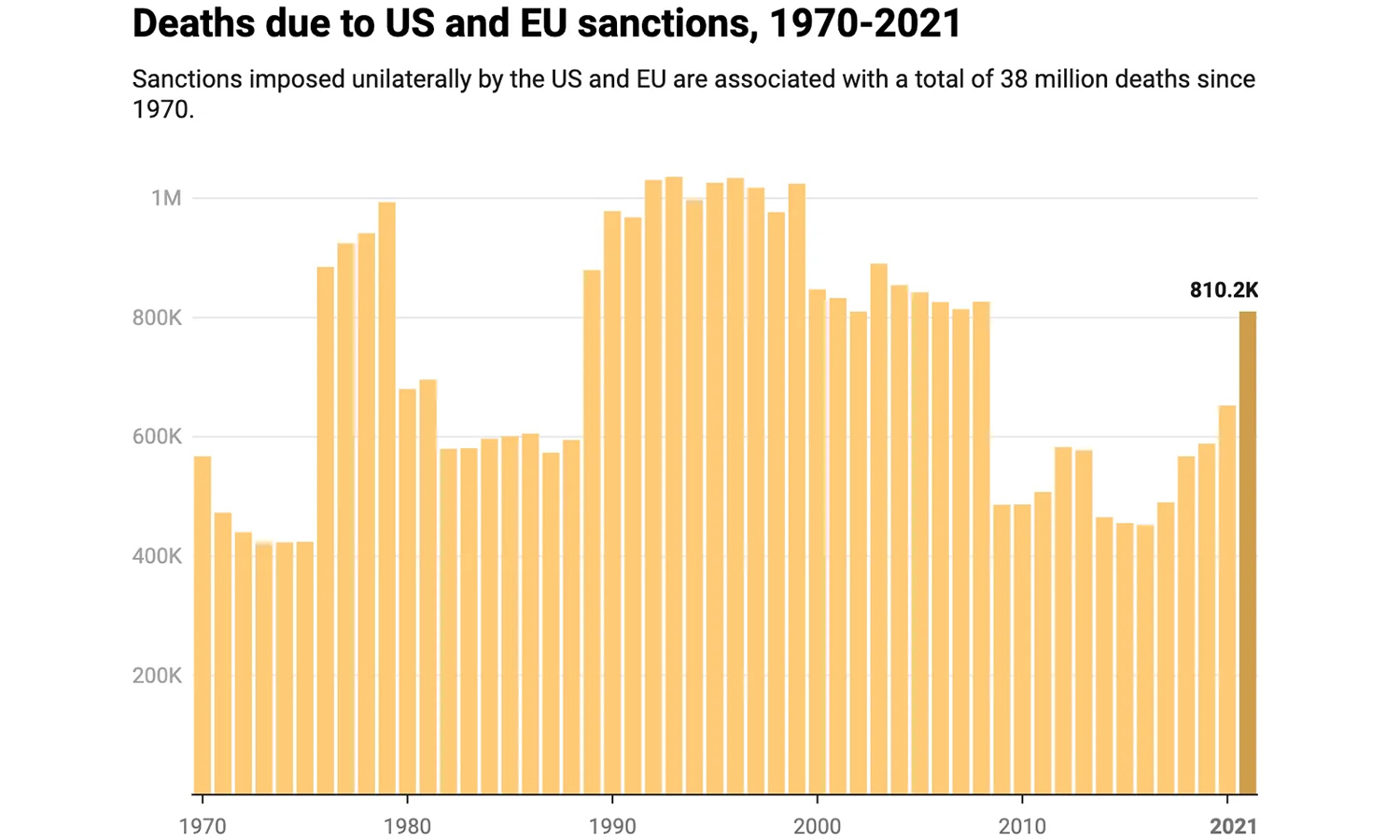This article is reproduced from Moon of Alabama, with thanks.
Since the article was published, some developments of note have taken place. The first was the wiping out a huge part of the valuation of US chip monopoly Nvidia, which lost $600bn in a single day and nearly $1tn in a week following the news that its highest-end chips were not, as previously believed, an essential prerequisite for creating a functioning chatbot.
OpenAI, the company that has produced the much-hyped ChatGPT AI interface using Nvidia high-performance chips and a hugely expensive data centre, is about to go public with an expected valuation of $300bn. Despite huge funding and income, the company made a $5bn loss last year, but was expected to pay its investors with a huge growth in sales income in 2025.
US-based tech monopolies in Silicon Valley have been hoovering up investment on the basis that they are in a position to monopolise AI, which they have been promoting as the ‘next big thing’. Their entire business model has been based on the assumption that they will be in a position to charge whatever they like for the use of their ‘essential’ service, since it will have no competitors.
There is every chance that a bursting of the AI-driven stock market bubble could ensue, and precipitate another sharp downward turn in the already severe global crisis of overproduction.
Another interesting development was the apparent admission by DeepSeek’s programers that their innovative approach to the problem of generating a more efficient AI computing model was based on a long-ignored piece of Soviet computer code (or possibly an algorithm). (Note that cold war propaganda always assured us that the USSR was decades behind the west when it came to computing.)
According to The Islander Telegram channel: “DeepSeek, the AI titan shaking up the tech world, wasn’t born in Beijing boardrooms or Silicon Valley labs. It was built on the forgotten code of the Soviet Union.” (2 February 2025)
We have been unable to verify this claim, but if true in any way, it is a timely reminder that it is socialism which truly excels in scientific and technological development, innovation and creativity.
While capitalism wastes human potential on an industrial scale, and innovates only in so far as it can make maximum profit, socialism harnesses the full creative power of all the members of its society and puts no artificial barriers in the path of technological development.
Despite all the cold war indoctrination to the contrary, and the experience of living through three decades of US imperialist dominance after 1991, workers should take note of the fact that the advent of the socialist era, which began in 1917, is ultimately what has spelt doom for the imperialist system.
As China and others are showing today, there is no longer any possibility that the imperialists will be able to hang onto their technological and military dominance – and without that dominance, there is no way for them to maintain their position as masters of the planet once the oppressed masses organise themselves to rebel.
*****
The hype around artificial intelligence (AI), the now failed US attempt to monopolise it, and the recent counter from China are a lesson in how to innovate. They also show that the USA is losing the capability to do so.
In mid 2023, when the artificial intelligence hype gained headlines, I wrote:
“‘Artificial intelligence’ is (mostly) glorified pattern recognition
“Currently there is some hype about a family of large language models like ChatGPT. The program reads natural language input and processes it into some related natural language content output. That is not new. The first Artificial Linguistic Internet Computer Entity (Alice) was developed by Joseph Weizenbaum at MIT in the early 1960s.
“I had funny chats with Eliza in the 1980s on a mainframe terminal. ChatGPT is a bit niftier and its iterative results – ie, the ‘conversations’ it creates may well astonish some people. But the hype around it is unwarranted …
“Currently, the factual correctness of the output of the best large language models is an estimated 80 percent. They process symbols and pattern but have no understanding of what those symbols or pattern represent. They can not solve mathematical and logical problems, not even very basic ones.
“There are niche applications, like translating written languages, where AI or pattern recognition has amazing results. But one still cannot trust them to get every word right. The models can be assistants but one will always have to doublecheck their results.
“Overall, the correctness of current AI models is still way too low to allow them to decide any real-world situation. More data or more computing power will not change that. If one wants to overcome their limitations, one will need to find some fundamentally new ideas.” (2 June 2023)
But the hype continued. One big AI model, ChatGPT, was provided by a non-profit organisation, OpenAI. But its CEO, Sam Altman, soon smelled the big amount of dollars he potentially could make.
A year after defending the the non-profit structure of OpenAI, Altman effectively raided the board and took the organisation private:
“ChatGPT-maker OpenAI is working on a plan to restructure its core business into a for-profit benefit corporation that will no longer be controlled by its non-profit board, people familiar with the matter told Reuters, in a move that will make the company more attractive to investors …
“Chief executive Sam Altman will also receive equity for the first time in the for-profit company, which could be worth $150 billion after the restructuring as it also tries to remove the cap on returns for investors, sources added.” (OpenAI to remove non-profit control and give Sam Altman equity, sources say by Krystal Hu and Kenrick Cai, Reuters, 26 September 2024)
The ChatGTP large language model OpenAI provided was closed source. A black box, running in the cloud, that one could pay to chat with or use for translating, content generation or analysing certain problems.
The training and maintaining of ChatGTP took large amounts of computing power and money. It was somewhat expensive but there was no new technology in it. The algorithms it used were well-known and the training data needed to ‘program’ it were freely available internet content.
For all the hype about AI, it is not a secret or even new technology. The barriers to entry for any competition is low.
That is the reason why Yves at Naked Capitalism, pointing to Edward Zitron, asked: “How does OpenAI survive?” It doesn’t. Or has little chance to do so. Discussions in the USA never acknowledged those facts.
Politicians thought of AI as the next big thing that would further US control of the world. They attempted to prevent any potential competition to the lead the US thought it had in that field. Nvidea, the last leading US chip maker, lost billions when it was prohibited from selling its latest AI-specialised models to China.
Two days ago Trump announced Stargate, a $500bn AI infrastructure investment in the USA:
“Three top tech firms on Tuesday announced that they will create a new company, called Stargate, to grow artificial intelligence infrastructure in the United States.
“OpenAI CEO Sam Altman, SoftBank CEO Masayoshi Son and Oracle chairman Larry Ellison appeared at the White House on Tuesday afternoon alongside President Donald Trump to announce the company, which Trump called the ‘largest AI infrastructure project in history’.
“The companies will invest $100bn in the project to start, with plans to pour up to $500bn into Stargate in the coming years. The project is expected to create 100,000 US jobs, Trump said.
“Stargate will build ‘the physical and virtual infrastructure to power the next generation of AI’, including data centres around the country, Trump said. Ellison said the group’s first one million-square foot data project is already under construction in Texas.” (Trump announces a $500bn AI infrastructure investment in the US by Clare Duffy, CNN, 21 January 2025)
On the very same day, but with much less noise, a Chinese company published another AI model:
“We introduce our first-generation reasoning models, DeepSeek-R1-Zero and DeepSeek-R1. DeepSeek-R1-Zero, a model trained via large-scale reinforcement learning (RL) without supervised fine-tuning (SFT) as a preliminary step, demonstrated remarkable performance on reasoning.
“With RL, DeepSeek-R1-Zero naturally emerged with numerous powerful and interesting reasoning behaviours.” (Deepseek-R1, Huggingface.co)
The new DeepSeek models have better benchmarks than any other available model. They use a different combination of techniques, less training data and much less computing power to achieve that. They are cheap to use and, in contrast to OpenAI, real open source.
Writes Forbes: “US export controls on advanced semiconductors were intended to slow China’s AI progress, but they may have inadvertently spurred innovation. Unable to rely solely on the latest hardware, companies like Hangzhou-based DeepSeek have been forced to find creative solutions to do more with less …
“This month, DeepSeek released its R1 model, using advanced techniques such as pure reinforcement learning to create a model that’s not only among the most formidable in the world, but is fully open source, making it available for anyone in the world to examine, modify and build upon …
“DeepSeek-R1’s performance is comparable to OpenAI’s top reasoning models across a range of tasks, including mathematics, coding and complex reasoning. For example, on the AIME 2024 mathematics benchmark, DeepSeek-R1 scored 79.8 percent compared to OpenAI-o1’s 79.2 percent. On the MATH-500 benchmark, DeepSeek-R1 achieved 97.3 percent versus o1’s 96.4 percent.
“In coding tasks, DeepSeek-R1 reached the 96.3rd percentile on Codeforces, while o1 reached the 96.6th percentile – although it’s important to note that benchmark results can be imperfect and should not be overinterpreted.
“But what’s most remarkable is that DeepSeek was able to achieve this largely through innovation rather than relying on the latest computer chips.” (DeepSeek: How China’s AI innovators are challenging the status quo by Craig Smith, 22 January 2025)
Nature is likewise impressed: “A Chinese-built large language model called DeepSeek-R1 is thrilling scientists as an affordable and open rival to ‘reasoning’ models such as OpenAI’s o1 …
“‘This is wild and totally unexpected,’ Elvis Saravia, an AI researcher and cofounder of the UK-based AI consulting firm DAIR.AI, wrote on X.
“R1 stands out for another reason. DeepSeek, the start-up in Hangzhou that built the model, has released it as ‘open-weight’, meaning that researchers can study and build on the algorithm. Published under an MIT licence, the model can be freely reused but is not considered fully open source, because its training data has not been made available.
“‘The openness of DeepSeek is quite remarkable,’ says Mario Krenn, leader of the Artificial Scientist Lab at the Max Planck Institute for the Science of Light in Erlangen, Germany. By comparison, o1 and other models built by OpenAI in San Francisco, California, including its latest effort o3 are ‘essentially black boxes’, he says.” (China’s cheap, open AI model DeepSeek thrills scientists by Elizabeth Gibney, 23 January 2025)
Even long term internet investors, who have seen it all, are impressed: “Deepseek R1 is one of the most amazing and impressive breakthroughs I’ve ever seen – and as open source, a profound gift to the world.” (Marc Andreessen post, Twitter/X, 24 January 2025)
Nature adds: “DeepSeek hasn’t released the full cost of training R1, but it is charging people using its interface around one-thirtieth of what o1 costs to run. The firm has also created mini ‘distilled’ versions of R1 to allow researchers with limited computing power to play with the model.” (Op cit)
That does in fact work!
“Folks, I think we have done it!
“If overnight tests are confirmed we have OPEN SOURCE DeepSeek R1 running at 200 tokens per second on a NON-INTERNET connected Raspberry Pi.
“A full frontier AI better than ‘OpenAI’ owned fully by you in your pocket free to use!
“I will make the Pi image available as soon as all tests are complete.
“You just pop it into a Raspberry Pi [a low-cost credit card-sized computer board] and you have AI!
“This is just the start of the power that takes place when you TRULY open source an AI model.” (Brian Roemmele post, Twitter/X, 23 January 2025)
The latest Rasberry Pi hardware starts at $50. The software is free.
This is a death call for OpenAI:
“Most people probably don’t realise how bad news China’s Deepseek is for OpenAI.
“They’ve come up with a model that matches and even exceeds OpenAI’s latest model o1 on various benchmarks, and they’re charging just three percent of the price.
“It’s essentially as if someone had released a mobile on par with the iPhone but was selling it for $30 instead of $1,000. It’s this dramatic.
“What’s more, they’re releasing it open-source so you even have the option – which OpenAI doesn’t offer – of not using their API at all and running the model for ‘free’ yourself …” (Arnaud Bertrand post, Twitter/X, 21 January 2025)
The backstory of DeepSeek is also amazing.
In 2007, three Chinese engineers set out to build a quant (financial speculation) fund using AI. They hired hungry people fresh from the universities. Their High-Flyer fund was somewhat successful, but throughout the last years the Chinese government started to crack down on financial engineering, quant trading and speculation.
With time on their hands and unused computing power in their back room, the engineers started to build the DeepSeek models. The costs were minimal. While OpenAI, Meta and Google spent billions to build their AIs, the training costs for the published DeepSeek models were mere $5-6m.
“The lesson?
“Sometimes having less means innovating more. DeepSeek proves you don’t need:
– Billions in funding
– Hundreds of PhDs
– A famous pedigree
“Just brilliant young minds, the courage to think differently and the grit to never give up.” (Henry Shi post, Twitter/X, 20 January 2025)
Another lesson is that brilliant young minds should not be wasted to optimise financial speculation but to make stuff one can use.
DeepSeek demonstrates how it is impossible to use trade and technology barriers to keep technology away from competitors. They can, with decent resources, simply innovate around those.
Even billions of dollars, loud marketeers like Trump and self-promoting grifters like Sam Altman can not successfully compete with a deep bench of well-trained engineers.
As an author at Guancha remarks: “In the Sino-US science and technology war, China’s unique advantage comes precisely from the US ban. It can be said that our strong will to survive was forced out by Washington, and maximising our limited resources is the secret to breaking through.
“In history, this kind of story is not new. That is, the weak prevail over the strong, and the small fight against the big.
“The US side will fall into a Vietnam-style dilemma – relying too much on its own absolute advantage, thus wasting a lot of resources and losing itself to internal consumption.” (Chinese technology is elusive, and the United States is in a Vietnam War-style panic by Yan Mo, 24 January 2025, machine translation)
How long for the USA to (re-)learn that lesson?
















